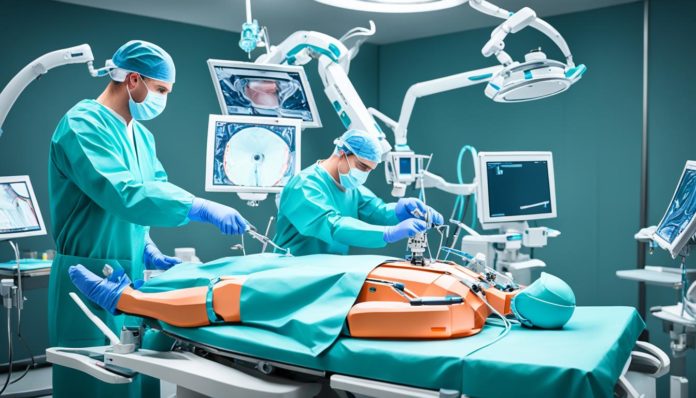Did you know over 90% of prostate cancer cases are found early? At this stage, surgeries like nerve-sparing can help a lot. These advanced surgeries aim not just to remove the cancer but also to keep the patient’s quality of life intact. There are many surgical options for prostate cancer, but minimally invasive techniques stand out for their success in preserving important functions.
Key Takeaways
- Nerve-sparing prostate cancer surgery aims to preserve erectile function by avoiding damage to specific nerves.
- This procedure is highly effective for patients with localized prostate cancer.
- Multiple surgical techniques, including robotic-assisted and laparoscopic surgery, are used in nerve-sparing procedures.
- Minimally invasive prostate surgery offers significant benefits, including faster recovery times and reduced postoperative pain.
- A comprehensive preoperative evaluation is necessary to determine the suitability of nerve-sparing surgery for individual patients.
Introduction to Advanced Nerve-Sparing Prostate Cancer Surgery
Prostate cancer surgery can bring side effects, varying by age and health. Advanced nerve-sparing prostate cancer surgery marks a big leap in treatment. It aims to protect sexual and urinary functions, improving life quality after surgery.

A key benefit of nerve-sparing prostate cancer surgery is keeping the nerves for erections safe. This greatly affects recovery and sexual health. Preserving these nerves tackles a major worry for men facing surgery.
In conclusion, nerve-sparing techniques are a beacon of hope in prostate cancer care. They strive for a sweet spot: removing cancer while keeping normal functions intact. This shows the advanced strides being made in treating prostate cancer.
What is Nerve-Sparing Prostate Cancer Surgery?
Nerve-sparing prostatectomy is a special surgery. It aims to remove the prostate gland while saving the nerves that control erections. It’s great for men getting a prostatectomy for prostate cancer.
The main aim of this surgery is to fight prostate cancer but also protect a man’s quality of life. Surgeons work carefully to save the neurovascular bundles around the prostate. This careful work helps men keep erectile function and control over urination after surgery.
This procedure is best for those whose cancer hasn’t spread beyond the prostate. Doctors choose patients for this surgery based on things like where their tumor is and their health overall. This ensures the surgery is effective and safe.
Recently, better surgical methods have made success rates of nerve-sparing surgeries even higher. Surgeons use advanced technology to get better results. This is a big plus for patients.

Techniques for Nerve-Sparing Prostate Cancer Surgery
There are multiple techniques for conducting nerve-sparing prostate cancer surgery. Each method has unique benefits depending on patient needs and clinical situations.
Robotic-Assisted Surgery
Robotic-assisted prostate surgery, known as robotic-assisted laparoscopic radical prostatectomy (RALP), brings precision to surgery. It uses detailed 3D imagery to improve the surgeon’s view. This reduces the chance of damaging nerves. It also counters hand tremors, allowing for precise movements.
Open Surgery
Open surgery is the traditional method. It involves a long incision for direct prostate access. Though more invasive, it’s vital for cases needing direct manual intervention.
Laparoscopic Surgery
Laparoscopic surgery involves small cuts below the belly button. It uses a camera for inside view. This method speeds up recovery by using advanced techniques similar to robotic surgery.
| Technique | Key Features | Advantages |
|---|---|---|
| Robotic-Assisted Surgery | Magnified 3D imagery, minimized hand tremors | High precision, reduced nerve damage |
| Open Surgery | Single long incision, direct access | Comprehensive access, straightforward intervention |
| Laparoscopic Surgery | Small incisions, laparoscope for visibility | Minimally invasive, quicker recovery |
Benefits of Nerve-Sparing Surgery in Prostate Cancer Treatment
The benefits of nerve-sparing surgery in prostate cancer care are vast and greatly improve recovery. This method aims to save the critical nerves that manage urinary and sexual functions. Thus, many patients keep their sexual potency and control over urination after the surgery.
Research highlights significant enhancements in men’s health after nerve-sparing surgery. Depending on each patient’s health, the surgery has impressive perks:
- Preservation of Urinary Control: One of the top advantages is keeping urinary control. This is unlike other surgeries that can cause lasting urinary issues.
- Retention of Sexual Function: Maintaining the ability to have erections after surgery is crucial for men. Nerve-sparing methods help men keep this ability, improving life post-surgery.
Prostate cancer surgery recovery is often smoother and quicker with nerve-sparing techniques. It highlights why this approach is vital in modern prostate cancer care.
In summary, the benefits of nerve-sparing surgery go far beyond just the surgery. They significantly boost the patient’s life quality in the long run.
Ideal Candidates for Nerve-Sparing Prostate Cancer Surgery
Choosing nerve-sparing prostate cancer surgery requires careful thought. It’s for patients whose health and condition fit the surgery’s needs. Knowing these factors helps pick the best surgery and increase its success.
Localized Prostate Cancer
Patients with cancer only in the prostate are great for nerve-sparing surgery. This allows doctors to save nerves around the prostate. Keeping sexual and urinary functions is key. Research shows the lasting benefits of this surgery for the right patients.
Overall Health
A patient’s health plays a big role in deciding on this surgery. Age, how long they’re expected to live, and other health issues matter. Doctors compare surgery risks with its possible gains.
A detailed health check is done. It makes sure the patient is healthy enough for surgery. This helps in a faster and better recovery.
When talking about this surgery, doctors look closely at the patient’s health and cancer details. This leads to treatment that fits the patient better and has more success.
Preoperative Preparations for Prostate Cancer Surgery
Getting ready for prostate cancer surgery is very important. It helps make sure the surgery goes well. This process includes a medical check-up and talking about the surgery risks and benefits.
Medical Evaluation
First, there’s a thorough medical check-up. It often starts with a prostate biopsy. This checks the cancer stage and spread. Then, MRI or CT scans might be done for more details about the cancer.
Doctors also look at the patient’s overall health. They check for other health issues that might affect the surgery success. Blood tests, EKGs, and lung function tests are common. They help see if the patient is ready for surgery.
Discussing Risks and Benefits
It’s important to talk about the surgery risks and benefits with the doctor. This chat helps patients know about possible problems like infections and erectile dysfunction. It ensures they know what they’re agreeing to.
It’s also key to understand the surgery’s good points. Benefits include possibly getting rid of the cancer completely. There’s also a chance for better survival rates. And, surgery might save nerve function, which helps with sexual and urinary health.
| Aspect | Details |
|---|---|
| Medical Evaluation | Prostate biopsy, blood tests, EKG, pulmonary function tests |
| Discussing Risks | Infections, erectile dysfunction, urinary incontinence |
| Discussing Benefits | Complete cancer removal, improved survival rates, potential nerve function preservation |
Postoperative Care and Recovery
After prostate surgery, it’s crucial to have good postoperative care for a fast recovery. Patients should follow a detailed recovery plan. This avoids complications and speeds up healing.
Pain Management
Managing pain well is key after prostate surgery. Doctors give pain medicine, and it’s important for patients to take them as directed. Using cold therapy and getting enough rest can also help ease pain and lower swelling. Watching for infection signs at the surgery site is critical to avoid more problems.
Physical Rehabilitation
Physical rehab is very important in recovery from prostate cancer surgery. Doing physiotherapy, especially pelvic floor muscle exercises, helps regain strength and improve bladder control. To avoid issues like chest infections or blood clots, it’s good to start moving and walking soon after surgery. A good rehab plan often includes:
- Pelvic floor exercises
- Slowly doing more physical activity
- Regular check-ins with physiotherapists
Physical rehab aims to get you back to your normal activities and also improve your overall health. By following these steps and keeping up with visits to healthcare providers, recovery can be smoother and more complete.
Robotic-Assisted Nerve-Sparing Prostate Cancer Surgery
Robotic-assisted nerve-sparing prostate cancer surgery is a major leap forward. It uses robotic-assisted prostate surgery for greater precision. This approach helps remove cancer while saving nerves. Surgeons at top places like Johns Hopkins use robots for a clearer, 3-D view of the prostate. This lets them tell cancerous tissue from healthy tissue better.
This surgery aims to reduce common side effects, like incontinence and erectile dysfunction. Advanced surgical techniques are key. They save the nerves important for a good life.
Robotic surgery for prostate cancer has many pluses:
- It brings heightened accuracy through better, clearer views of the area being operated on.
- Robots offer more control and movement than old methods.
- It often means less blood loss and quicker recovery.
These high-tech methods have changed how prostate cancer is treated. They lead to better results with fewer issues.
| Advantages | Description |
|---|---|
| Minimal Invasive | Robotic-assisted surgery involves small incisions, leading to faster recovery and reduced scarring. |
| High Precision | The robotic system allows for precise movements, improving the accuracy of nerve-sparing efforts. |
| Enhanced Visualization | Surgeons gain a three-dimensional view, permitting better differentiation between tissue types. |
Managing Side Effects and Complications
Nerve-sparing prostate cancer surgery helps keep nerve function. But, it’s key to tackle side effects for full recovery. Problems like erectile dysfunction and urinary incontinence can lower life quality after surgery.
Erectile Dysfunction
Erectile dysfunction is a common issue after prostate surgery. It might happen if nerves get damaged. To help, medicines like sildenafil (Viagra), tadalafil (Cialis), or vardenafil (Levitra) are used. They improve blood flow to help with erections.
Other aids include vacuum erection devices, penile implants, and living healthy. It takes time to recover. Talking openly with doctors is crucial to find the right treatment.
Urinary Incontinence
Urinary incontinence is another challenge after surgery. Patients may leak urine or feel the need to go often. Doing pelvic floor muscle exercises, like Kegels, can strengthen bladder control.
Sometimes, meds are needed to ease urinary symptoms. Getting better takes months, but learning and doing exercises helps regain control.
FAQ
What is Nerve-Sparing Prostate Cancer Surgery?
Nerve-Sparing Prostate Cancer Surgery removes the prostate while saving the nerves that control erections. It’s for patients whose cancer hasn’t spread beyond the prostate. The goal is to keep normal sexual and urinary functions after surgery.
What are the different techniques used for Nerve-Sparing Prostate Cancer Surgery?
Techniques include robotic-assisted, open, and laparoscopic surgery. Robotic-assisted uses robots for precision and 3D views. Open surgery uses a single big cut for access. Laparoscopic is less invasive, with small cuts and a camera for visibility.
What are the benefits of Nerve-Sparing Prostate Cancer Surgery?
The main benefit is preserving sexual and urinary functions. Studies show men with this surgery have better urinary control and erection capabilities compared to non-nerve-sparing surgeries.
Who are the ideal candidates for Nerve-Sparing Prostate Cancer Surgery?
Ideal candidates have localized cancer that hasn’t spread. Decisions consider the patient’s health, life expectancy, and surgery benefits versus risks.
What preoperative preparations are necessary for Prostate Cancer Surgery?
It involves medical checks and a biopsy to determine cancer spread. Discussing the surgery’s risks and benefits with a surgeon is key. Patients must understand complications like infection, erectile dysfunction, and urine leaks.
What does postoperative care and recovery involve after Prostate Cancer Surgery?
It includes managing pain and rehab. Monitoring for infection and encouraging movement to avoid other issues is vital. Rehabilitation includes pelvic exercises for better bladder control.
What role does robotic-assisted technology play in Nerve-Sparing Prostate Cancer Surgery?
Robotic-assisted surgery uses advanced tech for better precision and control. Johns Hopkins urologists use robotic systems for a clearer, 3D view. This aims to minimize side effects while accurately removing the prostate and saving nerves.
How are side effects such as erectile dysfunction managed post-surgery?
Post-surgery, managing erectile dysfunction may include drugs like sildenafil. Recovering erections takes time and might not be full. Rehab focuses on improving potential with therapy or other doctor-recommended treatments.
How is urinary incontinence managed after Nerve-Sparing Prostate Cancer Surgery?
Post-surgery, bladder control improves with pelvic floor muscle exercises. Medications could also help. A consistent rehab routine is key for effective outcomes.


